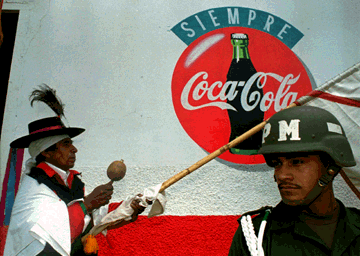Jan
26
The Faces of Popular Culture
Posted by: Brian | January 26, 2009 | Comments Off on The Faces of Popular Culture
While this article was very long and covered an incredibly large body of information that was at times a bit daunting, it was nonetheless, very interesting. It would be impossible to attempt to comment on everything so I will comment on a few key themes that I noticed through and through. One point that the author seemed to really drill in is the fact that in Latin America, popular culture is quite often the result of a hybridization between many elements of indigenous and European influence, and as the mixing between the rural and the urban. While very superficially it can be stated that indigenous civilizations were “crushed” in a sense by conquest and colonialism, these indigenous traditions are still very prevalent and are integrated into Latin American Culture.
This hybridization can be seen in many elements of culture including music, religion, story telling, poetry, and theatre, etc. The author speaks of “popular Catholicism” which refers to a type of Catholicism which is popularly practiced that mixes traditions of both “official” Catholicism (ie how the Spanish had perhaps intended the religion to be practiced) and how it has come to be practiced defined by the mixing of many religious ideas coming together. Relics such as The Virgin of Guadalupe and the Day of the Dead festival are examples of how these practices have come together over time.
After reading this article, I feel that I have come to look at popular culture in a different way. Rather than merely accepting it at face value, I feel that this article sheds light upon how much history is directly embedded into the popular cultural practices of today, and how much popular culture is influenced by socio-cultural structures throughout time. Just as Latin America is made up of many different histories (ie indigenous stories, stories of colonization, the idea of the mestizo identity, and differing power structures throughout history) these many elements seem to directly influence popular culture in a way that is often overlooked.
On page 138 the author writes: “…the development of capitalism in Brazil entailed the formation of a black subculture whose response to the harsh reality of discrimination and exploitation led to a rejection of the work ethic and to a counter-culture of idealization and idleness and of the body as a source of pleasure rather than as an instrument of work.” This quote made me think about the concept of culture as a coral reef and how culture does not merely naturally exist and change over time in an almost spontaneous unconcious manner, but rather is defined by a direct reaction to social forces that define reality atat the time and have perpetually defined reality through out history.
